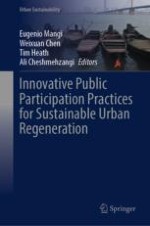2024 | OriginalPaper | Buchkapitel
6. Improving Liveability Through Regenerating Informal Neighbourhoods: A Case of Old Dhaka, Bangladesh
verfasst von : Md. Nawrose Fatemi, Zareen Habiba Islam, Tahmina Rahman
Erschienen in: Innovative Public Participation Practices for Sustainable Urban Regeneration
Verlag: Springer Nature Singapore
Aktivieren Sie unsere intelligente Suche, um passende Fachinhalte oder Patente zu finden.
Wählen Sie Textabschnitte aus um mit Künstlicher Intelligenz passenden Patente zu finden. powered by
Markieren Sie Textabschnitte, um KI-gestützt weitere passende Inhalte zu finden. powered by
